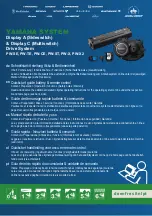
JOHNSON CONTROLS
10
FORM 160.00-O1 (1020)
occur on the DC link of the filter phase bank assembly.
The “trap” filter
is composed of a series of capacitors
(C84-C92), inductors (4L-6L) and resistors (16RES-
18RES). The “trap” filter acts as a low impedance for
a range of frequencies centered at the PWM switching
frequency of the filter (20 KHz). The purpose of the trap
is to block currents at the switching frequency of the filter
from getting onto the power mains.
The three phase inductor
provides some impedance
for the filter to “work against”. It effectively limits the
rate of change of current at the input to the filter to a
reasonable level.
T
he IGBT Phase Bank Assembly
is the most compli-
cated power component in the optional filter. Its purpose
is to generate the harmonic currents required by the
VSD’s AC to DC converter so that these harmonic cur-
rents are not drawn from the power mains. The phase
bank is composed of a series of IGBT modules (Q13-
Q18) mounted to a liquid cooled heatsink, a filter ca
-
pacitor “bank” (C67-C76) and an IEEE 519 Filter Gate
Driver board (031-01626) which provides the On and Off
gating pulses to the IGBT’s as determined by the 519
Filter Logic board. In order to assure an equal sharing
of the voltage between the series connected capacitors
on the filter bank, “bleeder” resistors 14RES and 15RES
are connected across the banks. In order to counteract
the parasitic inductances in the mechanical structure of
the phase bank, the filter incorporates “laminated bus”
technology and a series of small film capacitors (C77-
C83). The technology used is identical to that used in
the VSD’s DC to AC inverter section of the drive.
Various ancillary sensors and boards are used to convey
information back to the Filter Logic board. A thermistor
temperature sensor RT5 is mounted onto the liquid
cooled heatsink to provide temperature information.
Current Transformers 6T and 7T sense the input current
drawn by the VSD’s AC to DC converter. DC Current
Transformers DCCT1 and DCCT2 sense the current
generated by the optional filter. The Line Voltage Iso
-
lation board (031-01625) senses the input voltage to
the system, steps the voltage down to a safe level and
provides isolation between the Filter Logic board and
the power mains. The Bus Isolation board (031-01624)
incorporates three resistors to provide a “safe” impedance
between the DC filter capacitors located on the phase
bank assembly and the Filter logic board. It provides
the means to sense the positive, midpoint and negative
connection points of the filter’s DC link.
VSD CONTROL SYSTEM OVERVIEW
The VSD control system is composed of various com-
ponents located within both the Microcomputer Control
Center and the VSD, thus integrating the Control Center
with the VSD Drive. The VSD system utilizes various
microprocessors and Digital Signal Processors (DSPs)
which are linked together through a network of parallel
and serial communications links.
Micro Computer Control Center
The Microcomputer Control Center contains two boards
that act upon VSD related information, the Microboard
(031-01065) and the Adaptive Capacity Control board
(031-01579). The ACC board performs two major func-
tions in the VSD control system - (1) to act as a gateway
for information flow between the Micro Computer Control
Center and the VSD and (2) to determine the optimum
operating speed and vane position for maximum chiller
system efficiency by implementing a totally new and
novel means of Capacity Control.
The ACC board acts as an information gateway for all
data flowing between the VSD and the Control Center.
The ACC board communicates serially with both the
VSD logic board (via J8 on the ACC board) and the
optional Harmonic Filter logic board (via J9 on the ACC
board) using a pair of shielded cables. Once the infor-
mation is received by the ACC board, the information is
then passed on to the Microboard via two ribbon cables
connecting the ACC to the Microboard (J1 and J2 on
the ACC board).
In order to achieve the most efficient operation of a
centrifugal compressor, the speed of the compressor
must be reduced to match the “lift” or “head” of the load.
This “lift” or “head” is determined by the chilled and
condenser water temperatures (and their correspond-
ing refrigerant pressures). However, if the compressor
speed is reduced too much, the refrigerant gas will flow
backwards against the compressor wheel causing the
compressor to “surge”, an undesirable and extremely
inefficient operating condition. Thus there exists one
particular optimum operating speed (on the “edge” of
surge) for a given head, which provides the optimum
system efficiency. The compressor’s inlet guide vanes,
which are used in fixed speed applications to throttle
the gas flowing through the compressor, are controlled
together with the compressor speed on a VSD chiller
system, to obtain the required chilled water temperature
while simultaneously requiring minimum power from the
power system.
Содержание MILLENIUM 1100-46D
Страница 5: ...FORM 160 00 O1 1020 JOHNSON CONTROLS 5 THIS PAGE INTENTIONALLY LEFT BLANK ...
Страница 6: ...JOHNSON CONTROLS 6 FORM 160 00 O1 1020 ...
Страница 7: ...FORM 160 00 O1 1020 JOHNSON CONTROLS 7 ...
Страница 11: ...FORM 160 00 O1 1020 JOHNSON CONTROLS 11 THIS PAGE INTENTIONALLY LEFT BLANK ...
Страница 12: ...JOHNSON CONTROLS 12 FORM 160 00 O1 1020 FIG 4 IEEE 519 FILTER OPTION ...
Страница 13: ...FORM 160 00 O1 1020 JOHNSON CONTROLS 13 LD02725 ...
Страница 23: ...FORM 160 00 O1 1020 JOHNSON CONTROLS 23 NOTES ...










































